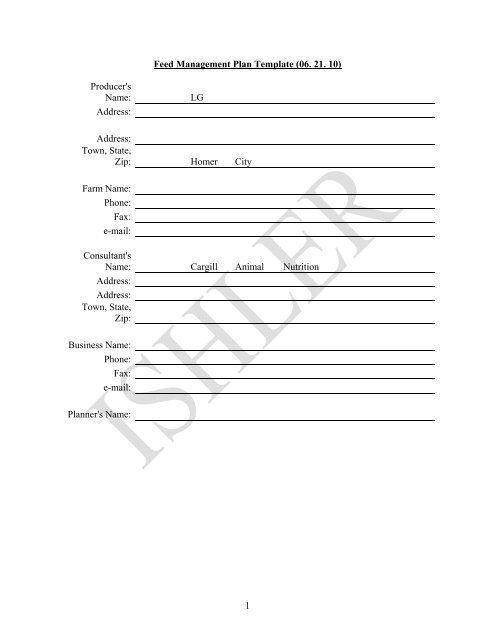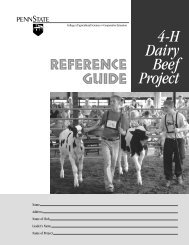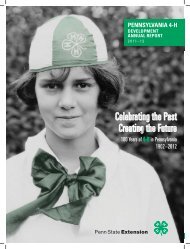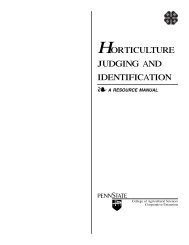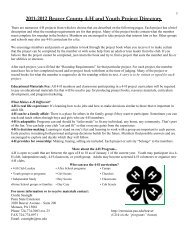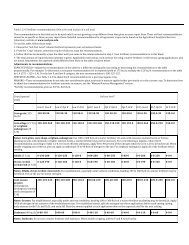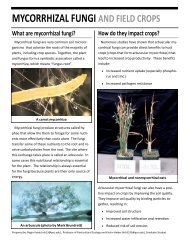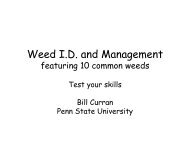Feed Management Plan Template - Penn State Extension
Feed Management Plan Template - Penn State Extension
Feed Management Plan Template - Penn State Extension
You also want an ePaper? Increase the reach of your titles
YUMPU automatically turns print PDFs into web optimized ePapers that Google loves.
General Purpose and Background<strong>Feed</strong>ing management is one of six components of a Comprehensive Nutrient <strong>Management</strong><strong>Plan</strong> (CNMP) as defined by the Natural Resource Conservation Service. <strong>Feed</strong> managementpractices may reduce the volume and nutrient content of manure and may be an effectiveapproach to minimizing the import of nutrients to the farm. <strong>Feed</strong> <strong>Management</strong> as part of aCNMP should be viewed as a “consideration” but not a “requirement” as some practices willnot be economical on some dairies. The <strong>Feed</strong> <strong>Management</strong> <strong>Plan</strong> (FMP) is designed to assistthe producer with documentation of those practices that affect whole farm nutrientmanagement and contribute towards achieving nutrient balance at a whole farm level.Nitrogen and phosphorus are the two nutrients that are required to be managed as part of aFMP in a CNMP. When nitrogen and phosphorus imports exceed nitrogen and phosphorusexports there is an imbalance at a whole farm level. These imbalances may lead to impairedwater quality in nearby water bodies due to both surface runoff or leaching of nutrients toground water. Excess nitrogen can also be volatilized and contribute to impaired air quality.Potassium is a nutrient that can lead to production and health problems if it is not monitoredin dairy rations, therefore it is included as a nutrient to monitor.Specific PurposeXXSupply the quantity of available nutrients required by livestock and poultry formaintenance, production, performance, and reproduction; while reducing the quantityof nutrients, especially nitrogen and phosphorus, excreted in manure by minimizingthe over-feeding of these and other nutrients.Improve net farm income by feeding nutrients more efficiently.Date <strong>Plan</strong> Written:The <strong>Plan</strong> will be reviewed at (whatinterval, i.e. yearly) and by whom:2
Surface Broadcast X X Xa. Days from application to Incorporation 1b. soil conditions:Cool SoilsCOOL SOILSWarm, Wet SoilsWarm, Dry SoilsCOOLSOILSCOOLSOILS4) Manure characteristics (Optional) EXAMPLE Facility 1 Facility 2% Ash (Optional)Harvested (after Storage; if sand or soil is added) 20%Dry weight of Bedding added (tons/ yr)Excluding soil or sandSand% Moisture 92%Liquid or slurry? Yes/ NoYES5
Summary of <strong>Feed</strong>ing Practices and Equipment/Technologies utilized on the farmNarrative of those practices that have been adopted and/or insert the completed Farm<strong>Plan</strong> Assessment Checklist.Include how diet formulation was achieved, to what standards (ie., NRC or proprietaryrecommendations, etc).Diets are formulated using Cargill’s program. Protein and phosphorus levels areformulated close to the animal’s requirements. Lactating cows are housed in a tiestallbarn and grouping by milk production or age is not feasible. The herd iscomponent fed with one grain mix. The feeding sequence is corn silage, grain, andhay. This sequence is fed three times per day.Indicate when lab analyses were conducted on feeds and by what lab.Forages are tested on a monthly basis or when there is an obvious change. Samplesare sent to Cargill’s lab.Indicate if nutrient analysis of drinking water was included in diet formulation. NONote the expected volume of manure excreted on manure storage requirements.The manure is stored in a uncovered storage as slurry. It has a storage capacity ofaround 6 months. The estimated volume is 118,000 gallons. The estimated excretionbased on milk production and dry matter intake is 18 gallons/cow. The annualexcretion by the herd (37 milk cows) is approximately 243,000 gallons using ASAEequations.Note the potential of any feed byproducts fed and their impact on nutrients in manure.Byproduct feeds are used in the grain mix at levels to balance protein andcarbohydrates in the ration. Good quality protein sources are used and severalcarbohydrate sources are used to maximize microbial protein production.Note the impact of feed management practices, animal management practices, and dietmanipulation on manure odors, pathogens, animal health and well-being.Nothing is currently been done to address these issues.Note use of manure on farm for production of forages and crops.Manure is applied in the spring and fall with primary application to fields for cornsilage and the remaining applied to hay fields.Make note of use of manure analysis (as excreted or stored) to estimate the impact offeeding strategies. Manure samples were sent to Cumberland Valley Lab.6
Record of <strong>Feed</strong> Sampling and <strong>Feed</strong> AnalysisDescribe routine feed analysis plan.• What feeds need to be sampled and when• What analyses need to be preformedNote why feeding rates for N and P may differ from recommendations (i.e. it is lessexpensive).The following records need to be kept for five years:Records of feed analysis and ration formulation, including initial ration formulation priorto development of FMP.Record of the initial estimate of the impact of adopted feed strategies on manure content.Record of any manure analysis that was done after the feeding strategy was implemented.Record of <strong>Feed</strong> Sampling and <strong>Feed</strong> AnalysisThe lactating cows have been selected for the feed management plan. Fecal sampleswill be taken from a composite group representing the average and peak producers(20 pounds higher than average). All forages and grain samples will be analyzed.The herd is not on DHIA. A bulk tank milk sample will be taken for MUN analysis.The fecal samples and forage and feed samples will be submitted to CumberlandValley Analytical Lab. Excluding the base line samples, samples will be taken 4times per year to represent the various seasons.The baseline data will be evaluated to examine opportunities for improvement basedon nitrogen and phosphorus. The following information will be monitored andevaluated. If there appears to be discrepancies in the formulated ration vs. theactual rations, the reason for these will be investigated and the problem areacorrected.Information monitored:1. I will monitor grain usage from the bin to check that the amount deliveredmatches with the grain feeding schedule.2. I will check the formulated grain mix with the analyzed results.3. I will average 3 bulk tank pick-ups and match the formulated ration moreclosely to actual milk production.4. I will monitor MUNs over time to evaluate if they are responding to rationchanges.7


